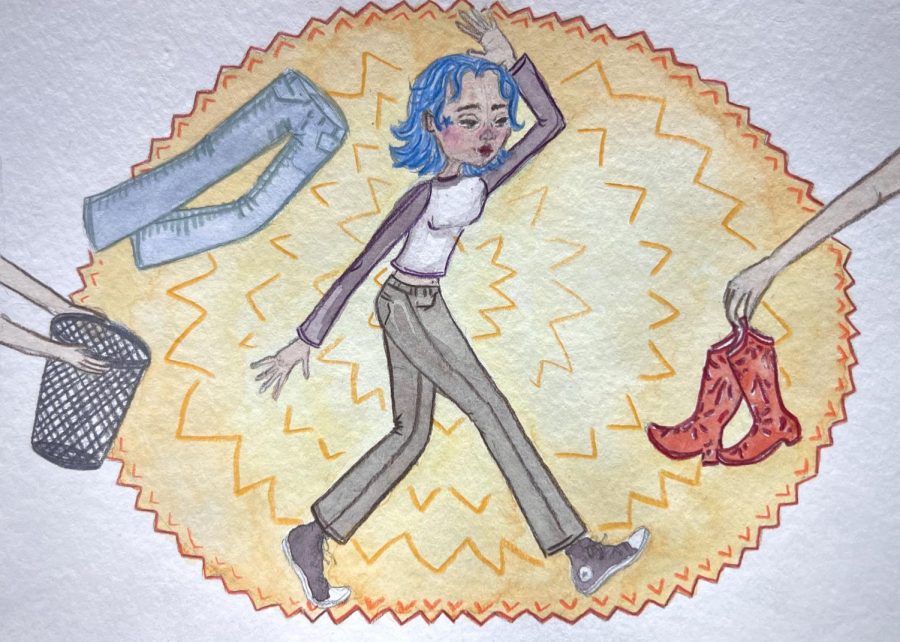Don’t let trends dictate your spending habits
February 6, 2023
I’ve never been someone who really kept up with trends.
Take a look at any of my middle school yearbook photos, and you’ll see the same sort of outfit over and over again: jeans, usually a striped shirt and a cardigan of some sort.
But as the internet and I both grew up, I was exposed to more and more trends that came and went almost as quickly as the seasons.
The pressure that keeping up with trends puts on young people not only promotes mental and emotional instability, but is bad news for our planet as well.
Traditionally, trends have existed on a cycle, flowing in and out of popularity about every 20 years, according to a May 2, 2022 Go Fish article.
We can see evidence of this cycle in the resurgence of Y2K fashion in recent years, almost perfectly hitting that 20-year mark.
However, there has been a recent rise in “macro-” and even “micro-” trends, and cycles have shrunk down to last anywhere from a few years to a few weeks, according to a Dec. 14, 2022 Vice article.
On TikTok, I’ve seen videos about fashion aesthetics such as “vanilla girl,” “coastal grandma” and “clean girl” all within a few minutes.
Without even diving into the underlying issues with some of these trends, the constant cycling of what’s “in” and what’s “out” is incredibly difficult to keep up with.
Let’s look at an example.
Say you see a video about a headband decorated with googly eyes. The likes and comments are through the roof.
Maybe you think it’s cute. Perhaps you just want to hop on the trend.
So you go online and find a nice googly-eyed headband. Let’s say it costs about $15, based on decorated headbands available on Etsy.
The average processing time for online orders is between one and three days, according to a Nov. 2, 2022 Tech with Tech article.
Add on the average shipping time of two to five days, and the headband might take a week to get to you.
By that point, the microtrend might already be half over, in the declining stage of the trend cycle.
So not only did you spend $15 on a headband that might be trending for a week, but the shipping process put more than a kilogram of carbon dioxide emissions into the environment, according to Consumer Ecology.
Additionally, microtrends like this are a major example of items that come out of the fast fashion industry, which uses the quick cycle of trends to pump out clothing to meet those demands, according to Jul. 29, 2022 Good On You article.
Fast fashion is a known environmental enemy, but when trends are coming and going as quickly as they are in our current social media age, it just allows for increased pollutants and negative environmental impacts as producers work to meet consumer demand.
In this day and age, it’s hard to stop yourself from purchasing things online. But the cost, monetarily and environmentally, isn’t worth it unless you’re buying something you’ll love for a long time.
Thrifting has long been considered a more sustainable alternative to fast-fashion shopping, but in a world of microtrends, even thrifting pushes the ideas of overconsumption and enforces the fast-fashion trend cycle, according to a Nov. 11, 2022 Vice article.
Beyond just the consumerism and environmental impact of these cycles, the psychological impacts can also have negative effects on consumers.
Peer pressure to keep up with fashion trends can start in adolescence and can have serious results, including depressive symptoms, development of psychotic thoughts and even suicidal tendencies, according to a 2021 study from the Journal of Fashion Technology & Textile Engineering.
And the pressure doesn’t stop at fashion. My social media is also full of users raving about their Stanley cups, spouting the benefits of a sober curious lifestyle or listing the reasons you should be going to pilates instead of lifting weights.
Trends can be useful for exploring your options and finding what habits and styles make you happy, but putting too much pressure on yourself to comply with media trends will only put you into a box.
When people make purchases they actually want as opposed to on-trend purchases, they’re more likely to pay more money for better quality, according to a Dec. 12, 2012 Women’s Wear Daily article.
And with better quality clothing comes a reduced environmental impact, according to Land’s End, increased consumer satisfaction, according to a 2019 paper from the Journal of Physics, and saving money in the long run, according to a Nov. 17, 2015 article from The Guardian.
So instead of adding things that are popular to your shopping cart, put your money and energy towards finding out what you really like.
By developing your own personal style, figuring out what colors, cuts and patterns you like, you may feel less inclined to succumb to the endless trend-cycling.
Not only will it improve your happiness, but your wallet and the planet will thank you, too.
